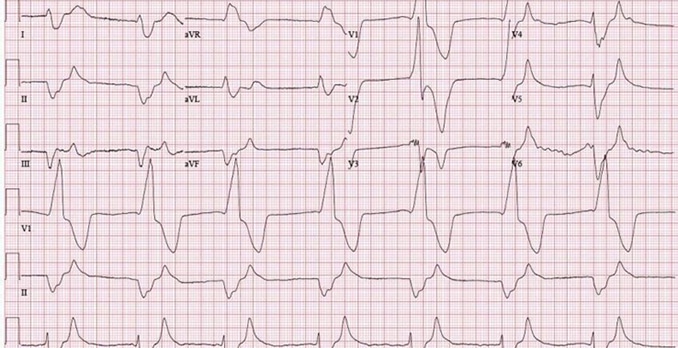1. This ECG is highly suggestive of severe hyperkalemia, based on the loss of P waves, tall and widened T waves, and grossly prolonged QRS duration (often described as a “sine wave”). Most cases of significant hyperkalemia are due to underlying renal insufficiency, with potassium levels increased by tissue breakdown (e.g., rhabdomyolysis), certain medications (e.g., potassium-sparing diuretics), or occasionally by hormonal deficiency (e.g., adrenal insufficiency).
Symptoms of severe hyperkalemia include fatigue, weakness, nausea, heart failure, and various cardiac arrhythmias.
This patient was recently started on spironolactone, and had a serum potassium of 8.6 mEq/L.
2. Treatment of symptomatic hyperkalemia should begin when there is reasonable clinical suspicion, as serum measurements may be delayed. Give intravenous calcium chloride or gluconate first to antagonize hyperkalemic cardiac effects. Sodium bicarbonate, dextrose with insulin, nebulized beta-sympathomimetics (as well as intravenous ones, including epinephrine) and intubation with hyperventilation shift potassium into cells. Loop diuretics (e.g., furosemide) and potassium-binding resins (e.g., Kayexalate) increase potassium excretion, although dialysis is the best removal method for severe hyperkalemia. Hence, referral may be indicated.
Case presented by John F. O’Brien, MD, FACEP. Dr. O’Brien is the associate residency director of the Department of Emergency Medicine at Orlando Regional Medical Center in Orlando, FL.
[taq_review]


